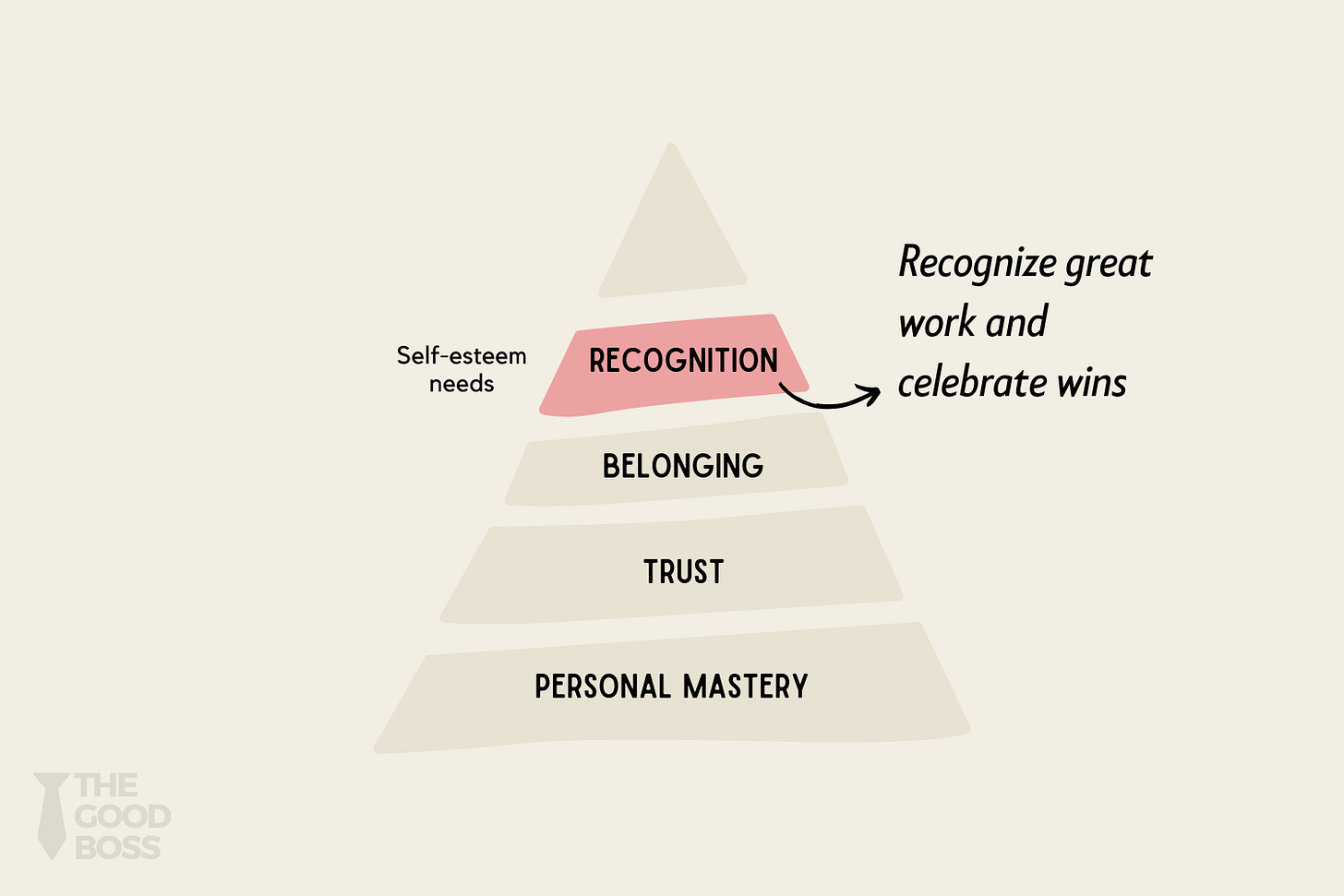In this issue:
1. Personal Mastery
2. Trust
3. Belonging
4. Recognition
5. Vision
In Summary: Maslow’s Hierarchy of Needs in Leadership
Download the Maslow’s Hierarchy of Needs Worksheet
Complementary Frameworks and Other Resources
Final Thoughts and Takeaways
“There is nothing, absolutely nothing, more important than meeting our basic human needs.” — Simon Cohen
In 1943 psychologist Abraham Maslow coined the idea of The Hierarchy of Human Needs, and how human motivation and behavior can be mapped to these needs.
At the most basic level, we have biological needs — food, shelter, warmth, and safety.
Once our basic needs are met, we develop psychological needs — such as love, belonging, and esteem.
Finally, as we continue to ascend our life’s development ladder, we reach the highest tier of needs — those of self-actualization. These include self-fulfillment, personal growth, and reaching the peak of our potential.
Leadership, much like human development, can be understood through the lens of Maslow’s Hierarchy of Needs.
In this issue, I will discuss Maslow’s Hierarchy of Needs in Leadership and how leaders can navigate these to better understand and appreciate their roles as leaders.
1. Personal Mastery
“One can have no smaller or greater mastery than the mastery of oneself.” — Leonardo da Vinci
As a leader, at the foundational level, you must meet the basic needs for personal mastery.
These form your physiological needs, and include the necessary skills and knowledge to get your job done. You must know your job, your domain, and your industry.
You must build your expertise, and continue to invest in self-improvement, skill development, and growth.
Depending on your level and role, you may need to focus on technical leadership, tactical execution, or strategic planning.
Personal mastery also includes self-awareness, and the recognition and appreciation of your strengths, weaknesses, and motivations.
To gain personal mastery for yourself and your teams, you should:
Build your expertise in your field, domain, industry
Continue to develop your skills and deepen your expertise
Be self-aware and recognize your strengths and weaknesses
Provide comprehensive onboarding and training programs.
Ensure employees have the necessary resources (hardware, software, workspace).
Regularly review workloads to avoid burnout and ensure work-life balance.
2. Trust
“You build trust with others each time you choose integrity over image, truth over convenience, or honor over personal gain.” — John C. Maxwell
Once you have acquired personal mastery, you move up to the next level of needs for any leader — fostering trust.
Just as individuals seek safety and security in their lives, leaders must create a sense of security and stability in their teams.
In The Five Dysfunctions of a Team, Patrick Lencioni talks about how the Absence of Trust sits at the core of a dysfunctional team.
As a leader, you must create a supportive environment by fostering trust so your team members feel valued and respected. You must actively mine for hidden conflicts, and ensure your teams trust each other and hold each other accountable.
You need to create an environment of psychological safety, where your team members feel safe to voice their thoughts and opinions, and are willing to take risks.
To foster trust, you should:
Create an environment of trust and psychological safety
Encourage thoughtful and objective disagreements
Be authentic and transparent in your communication
Implement clear policies for conflict resolution and career development.
Regularly check in on team morale and mental health.
3. Belonging
“A sense of belonging is one of humanity’s deepest longing.” -Brené Brown
As humans, we are social beings, and the next level in the hierarchy of needs for a leader is belonging.
As a leader, you need to cultivate a sense of belonging in your team, which includes fostering a sense of community, collaboration, and inclusivity.
You need to value each individual in your team as they are, and celebrate the diversity of thoughts and ideas. You need to make sure they feel part of a team, and that they feel comfortable working together towards the common business goals.
You can do this with intentional gatherings, celebrating successes, and creating opportunities for the team members to bond and get to know each other.
Creating a sense of belonging will not only lift the engagement level for your team, but also improve the business results and impact.
To foster a sense of community, you should:
Promote inclusivity and celebrate diversity of thoughts and ideas
Encourage collaboration and team bonding through intentional gatherings
Work towards a one-team mindset
Organize regular team-building activities and offsites.
Celebrate personal milestones and professional achievements.
Create mentorship programs to foster connection and collaboration.
4. Recognition
“People work for money, but go the extra mile for recognition, praise, and rewards.” — Dale Carnegie
The next level in the hierarchy of needs for leaders is recognition, which satisfies the self-esteem needs of their teams.
Who doesn’t like to be recognized and rewarded for their work? Well, I certainly do.
As a leader, you need to acknowledge and celebrate individual and team accomplishments. This not only motivates them, but energizes them to do even more and aim higher.
You need to cultivate a culture of recognition, where efforts are noticed and contributions are valued.
To promote a culture of recognition, you should:





